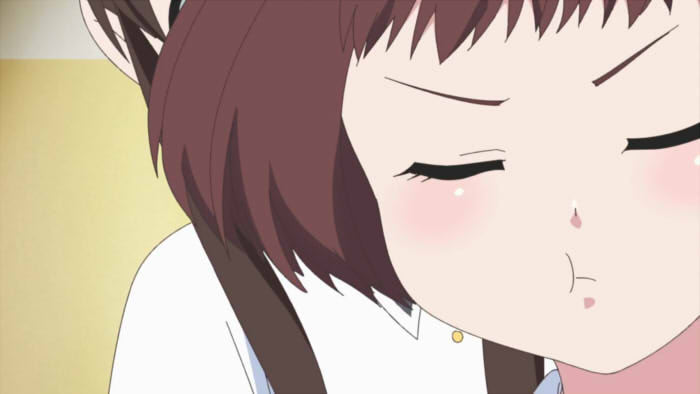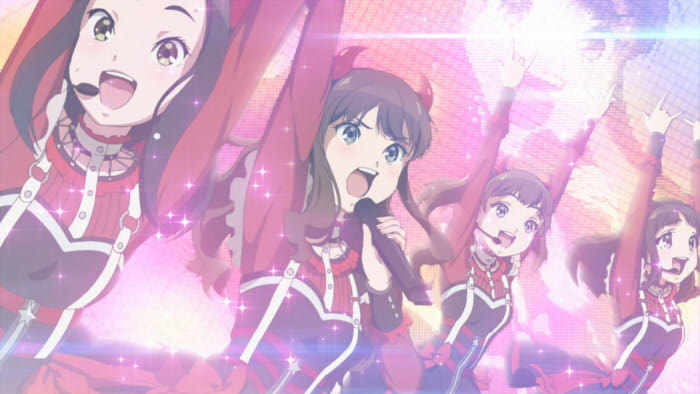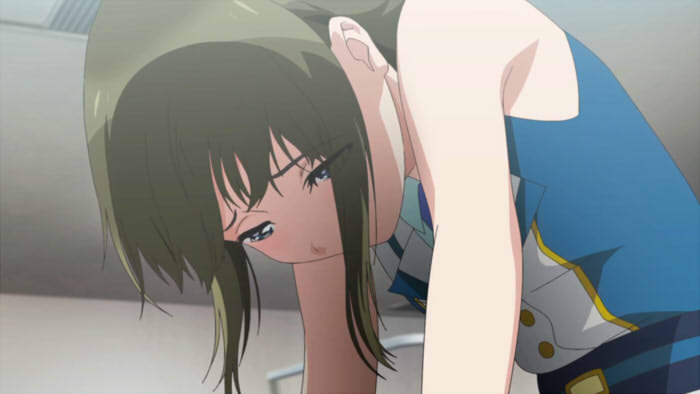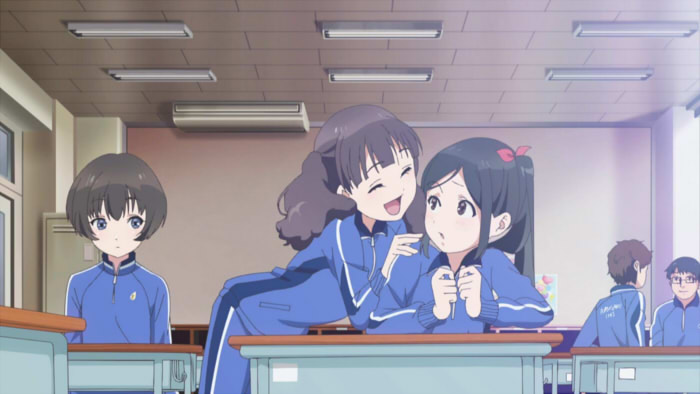Brand New All-Star WUG

If there is one thing you need to know prior to going into the new Wake Up Girls, it’s that Moka is kind of a tiny idol jerk.
If there’s another thing you need know, it’s that Moka ended up replacing Mayushi’s old friend/rival Shiho as the center of I-1 Club when they went head-to-head over the single sales of the Unmei no Megami single and her Team M version outsold Shiho’s Team S (Yes, they really called them Team S and M), causing Shiho to form I-1 affiliate unit Next Storm with a bunch of newbies. Their single was pretty good, a Love Live sub-unit single kind of way, if you’ve not heard it, but in the context of the show, getting away from the somewhat gross and hostile environment of the main I-1 Club ended up doing Shiho the world of good.

I’m saying that you may want to know this because I’m assuming it might be relevant at some point. It’s hard to tell, because Shiho was curiously absent from all the promotion material for the show, though Next Storm to at least show up briefly in the opening of the new TV show and Mayushi mentions them off-hand. It’s probably not necessary to watch two hours worth of old-WUG for the full context of it (though I think those movies are pretty OK), but it is something that happened.
But, anyway, the first episode of the new series of Wake Up Girls started today. It follows on from the next of the sequel movies, Seishun no Kage and Beyond the Bottom, which where released in 2015, but sees production move wholesale from under Yamamoto Yutaka at Ordet to under Itagaki Shin at Millepensee (who, admittedly, were already credited with co-production on those movies, replacing Tatsunoko from the TV show). It’s also sporting refreshed character designs by Sugawara Miyuki.
New WUG is pretty good. Of curious note is that the script for this episode was by Matsuda Eriko, who wrote a couple of episodes of WUGZoo (which is a pretty entertaining watch, coincidentally), and not a whole ton more, rather than Machida Touko, who literally penned every other piece of main-line WUG. The shows main composition credit still goes just to Green Leaves, as with the sequel movies, rather than anyone specific. The pacing of the dialogue in the episode feels a little snappier, somewhat jokier, if less naturalistic, than in previous WUGs, though given the circumstances, it’s a little hard to tell if that’s Itagaki exerting his influence or not.
The show does present some pretty high-tier “let’s not animate the mouths” cuts – I mean, look at this shot of Airi in particular.

She is totally talking in this cut, by the way
The backdrop to the new series of WUG is the decline of the idol industry. Well, sort-of. The local I-1 Club theatre is closing, and there’s some talk of a bad economy taking it’s toll. To a degree, it’s difficult to tell if this is supposed to indicate a decline in the popularity of idols (real-life AKB48 are still trucking along, if not quite at their peak, though), or if it’s a reflection of the same trend that Love Live Sunshine builds part of it’s narrative upon – market over-saturation, especially when it comes to the anime part of the idol equation, making achieving and maintaining success incredibly difficult. Just look at this anime season – most of the them are male-lead, but there’s still five or six new idol themed anime being broadcast, even discounting the incumbents like Aikatsu and PriPara, or the several others that feature idols as secondary characters.
When even the remake movies of a certain vintage robot show have apparently rewritten one of the characters as an idol, you know you are well beyond the normalisation point for tokenisation, and there’s only so much attention to divide amongst all these idols. I guess part of the point of this first episode of WUG is that, when even I-1 Club are struggling to keep enough butts in their theatres to make them a worthwhile concern, an also-run group like WUG, mildly notable only for pulling a minor upset against I-1 in a competition a couple of years back, are going to struggle to actually break out when every town has it’s own locodols vying for attention. It’s hard to make an impact.
(Unless, maybe, you happen to have an idol who happens to surprisingly speak perfect English)

The first couple of cuts of their introduction are waaaaaaay better animated than most the rest of the episode, coincidentally
The irony of the situation, perhaps, is that this episode introduces us to the girls we know from copious marketing materials will ultimately form Run Girls, Run, the second Green Leaves unit, bringing yet another idol unit into the world. Essentially formed of a pair of WUGners (the term Yamakan came up with to refer to WUG fans which, amusingly, has been adopted by the show itself only now that Yamakan is out) and an I-1 groupy, they likely look to be scouted via the oh-so-modern method of being found as Content Producers on Internet Streaming Services.
How, exactly, RGR end up actually being signed with Green Leaves is still a question to be answered – given the episode ends with WUG apparently Going On Tour (what could possibly go wrong!), maybe someone just figures they could do with a supporting act to lend them more legitimacy.
Still, whilst the show presents a backdrop of the decline of Idols, the shows overall tone is rather less oppressively cynical than the prior WUG shows tended to come across as. It’s… refreshing, maybe? Pleasant? Maybe it’ll persist, maybe it won’t. The show retains enough of the focus on the travails of the idol industry to still distinct from all those other idol shows in the way WUG traditionally has been, but lacks something of that after-taste. Of course, that’s what some people liked about the original WUG, and certainly that fine line it walked between criticising the idol industry and hypocritically marketing straight towards it’s fandom (because idol fans are bad, but only those idol fans) was one of the things that defined its character as a show, but what’s presented here thus far at least feels like it’s making up for it in other ways.

(Hey, I made it all the way through this post without mentioning the CG dancing! The issue here is maybe more to do with the way the dance sequences are shot more than the admittedly not spectacular CG – the camera work is a little too hyperactive in a fashion in which not even Love Lives opening credit sequences tends to be. There’s some nice exaggerations in some of the individual shots, but when one of the appeals has traditionally been that The Dances In The Show Are The Dances On Stage, not being able to see them properly most the time isn’t the best.
Kousaki Satoru’s music is still good, though…)
